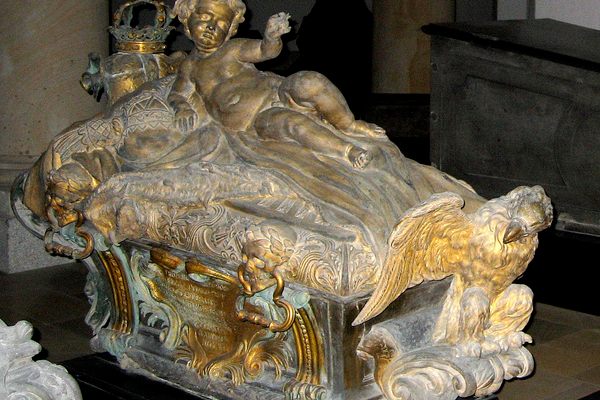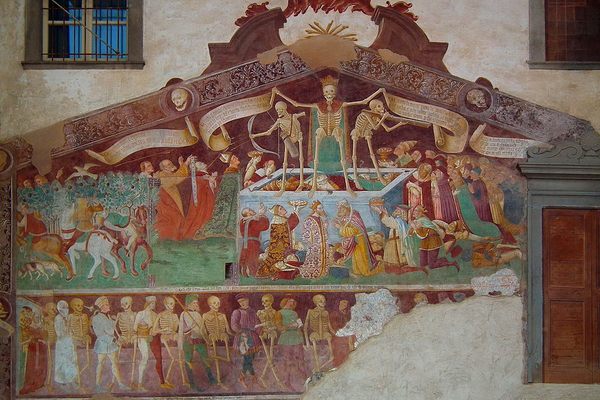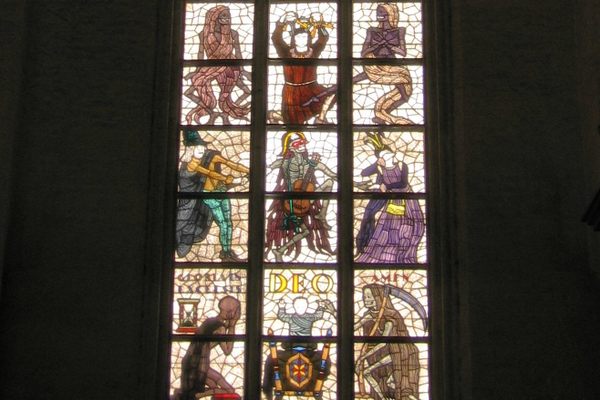'The Dance of Death'
At one of Berlin’s oldest churches, visitors can place mosaic tiles to help restore a medieval mural.
Lining the entrance hall of Marienkirche, one of the oldest churches in Berlin, are faint traces of paint outline a festive yet garish scene: the living dance hand-in-hand with the skeletal dead. The fresco dates back to 1485 and measures two meters high and 22 meters in length.
It was part of an artistic movement known as the Dance of Death (Totentanz in German) that swept Europe during the Middle Ages. With the onslaught of the bubonic plague and countless raging wars, death—and a gruesome death, at that—was a visible everyday reality for most Europeans. Preoccupation with mortality manifested in a religiously-inspired motif, wherein the living would be led by death—personified as a dancing corpse—to their demise. These images served as a reminder of one’s mortality and were intended as an inspiration to lead a pious life. The Dance of Death depicted people from all stations of life, from kings and bishops to children and peasants, testifying to the idea of death as the great equalizer.
Marienkirche, or Saint Mary’s Church, has been a mainstay of the Berlin cityscape since the 13th century and is one of the city’s few remaining buildings dating to the Middle Ages. The church’s longevity has led to a unique combination of architectural elements ranging from Gothic, Baroque, and Neo-Gothic styles. Along with the physical changes throughout the building’s history, the Marienkirche parish also underwent a radical religious transformation in 1539 when it rejected Catholicism and became Protestant during the Reformation.
At some point, Marienkirche’s Dance of Death fresco was painted over, then rediscovered in 1860 during renovations to the church. Though it is very faint, the fresco can still be seen by visitors and parishioners today behind a wall of protective glass. The Marienkirche parish is currently undertaking fundraising efforts to restore the painting. They’re offering uniquely interactive opportunities for would-be donors: the church has set up a mosaic model of the fresco where people can purchase a tile to add to the mosaic, with the proceeds funding the original’s restoration. Completing the model will take 70,000 tiles.
Aside from the Dance of Death fresco, Marienkirche is home to some of Berlin’s most exquisite examples of religious art, with works from the 15th to the 20th centuries. Many of these items were salvaged from other churches throughout the city that sustained damage during the Second World War. Marienkirche also serves as the final resting place for several notable members of its parish, with ornamental memorial and funerary art throughout the church serving as spectacular examples of memento mori.
Know Before You Go
Marienkirche is free and open to the public from 10 a.m. to 4 p.m. from January to March and from 10 a.m. to 6 p.m. from April to December. Please do keep in mind that this is an active church, and access may not be granted to the general public during worship times. Marienkirche's service schedule can be viewed on the church website.
If you would like to add a tile to the Dance of Death model mosaic, the suggested donation is € 2.50 per tile. The donation proceeds will be used for the restoration of the Dance of Death fresco.














Follow us on Twitter to get the latest on the world's hidden wonders.
Like us on Facebook to get the latest on the world's hidden wonders.
Follow us on Twitter Like us on Facebook